Konaev Dinmukhamed Akhmedovich (January 12, 1912 – August 22, 1993) is an outstandingstatesman and public figure and statesman, scientist, Academician of the Academy of Sciences of Kazakhstan (1952), Doctor of Technical Sciences (1969), three times the Hero of Socialist Labor (1972, 1976, 1982).
He was born on January 12, 1912 in city of Verny, now city of Almaty. He died on August 22, 1993, was buried in Almaty.
Biography
Kunaev Dinmukhamed Akhmedovich (Akhmetovich). (Konaev Dinmukhamed Akhmeduly) was born on January 12, 1912 in the city of Verny, now city of Almaty.
Kunaev Dinmukhamed Akhmedovich (in some documents it is indicated as Akhmedovich. Perhaps this was written in passport. – by the author B.G. Ayagan) [1, p.10].
The third volume of the national encyclopedia “Kazakhstan” (2005) indicates that his birthplace is Almaty. He died on August 22, 1993, was buried in Almaty [2, p. 360-361].
Ancestors of D.A. Kunaev were engaged in traditional Kazakh craft, they lived on the banks of the Kurty and Ili rivers, near the Verny fortress (Almaty).
In an autobiographical book D. Kunaev writes: “Each person must know his family tree. Without going back to ancient time, I can only say that my ancestors originate from Baidybek, the son of the Elder Zhuz. Baydybek himself, a warrior known for his valor, a defender of the people, was the son of Karashi Biy, famous for his wisdom and justice. … Our ancestors descended from his son (Zhalmambet) – Ysty” [3, p.12].
The great-grandfather of D.A. Kunaev moved, as the author of the book writes, “migrated to the lands of the Tobykty family” because of a discord with his relatives. Subsequently, he married the second son of Konai to a girl from Tobykty clan. Konay had a son Zhumabay and daughter Bulontay. Later Konai with his relatives returned to Semirechye.
Grandfather of D.A. Kunaev – Zhumabay was an educated person, he knew the Arabian, was a teacher in his native land. In 1904 he made a pilgrimage to Mecca and Medina. In 1886 his son Minliahmed was born (as in the text – by the author B.G. Ayagan). Fourteen-year-old Minliahmed served the merchant Iskhak Gabdul-Valiev and after the revolution of 1917 he worked in agricultural and trade organizations of the Almaty region.
His mother, Zaure Bairovna, was from in a poor peasant family in the village of Shelek (Chilik). She died in 1973. D.A. Kunaev’s uncle – Akhmetzhan Bairovich Chimbulatov, was a Komsomol and party worker, he was repressed in 1938. A. Chimbulatov had a great influence on the formation of the personality of D.A. Kunaev.
D.A. Kunaev’s father, Minliahmed, died in 1976, three months before reaching the age of ninety.

D.A. Kunaev, father Minliahmed Zhumabaiuly and mother Zaure Baiyrkyzy.
Personality. Memoirs about D.A. Kunaev/ Authors compilers: Abraimuly S., Goryainov A. – Almaty. 2007 – P. 80.
D.A. Kunaev received primary education at school number 19 named after N.G. Chernyshevsky.
Famous dancer Shara Zhienkulova later recalled: “At the time when I was studying in a small town of Verny at school number 19 named after Chernyshevsky, a bright, tall, smart boy Dima studied with us (as in the text – by the author B.G. Ayagan). He was very lively and courteous. The same Dima today is one of the sons respected by the people, is a comrade Dinmukhamed Akhmedovich Kunaev” [1, p.17].
After graduating from the fourth grade, he studied at school № 14.
D. Kunaev writes that he was inspired by the image of a major Kazakh engineer, Mukhamedzhan Tynyshpayev, who graduated from the St. Petersburg Institute of Railway Engineers in 1906.
In 1931, D.A. Kunaev entered the Moscow Institute of Non-Ferrous Metals and Gold. In Moscow he often visited cultural centers, theaters.

The Excellent pupils of the 2nd group of mining department of the faculty of Mintsvetmet.
Kunaev D. From Stalin to Gorbachev (In the aspect of the history of Kazakhstan). – Almaty, “Sanat”, 1994. – the 8th page of the insert.
At the same time D.A. Kunaev writes: “the studying period in Moscow coincided with the most difficult period in the life of the republic and the country – the period of forced collectivization. The Information about extremely difficult situation of people has reached even us, Moscow students. … I could judge about the scale of the unfolding disaster myself when I came back to my parents for a vacation to the village Turgen of Enbekshi-Kazakh district of Almaty region. Many people have died from starvation here, in the villages of Baltabay, Malovodnoe” [3, p.20-21].
Kazakh community invited the secretary of the Kazakh regional committee Kokhiani (as in the text, but correctly Kakhiani – by the author B.G. Ayagan) to a meeting in “Coliseum” Theater. The participants considered the information of the secretary of the regional committee was “extremely biased and unreliable.” A very brightly speaking student, Orazaly Dzhandosov (brother of Uraz Dzhandosov – by the author B.G. Ayagan), especially emphasized the terrible picture of a wide nation disaster – the famine he witnessed.
Merits
In July of 1936, after the completion of the institute, D.A. Kunaev was sent to the Kounrad-Balkhash construction. This was the beginning of his labor activity.
Working at heavy industry enterprises D. Kunaev became a participant of the formation of copper industry in Central Kazakhstan and later – of the plumb-zinc industry in Rudny Altai. The young engineer proved himself as a competent and qualified specialist. For example, the newspaper “Balkhash Worker” dated by February 5, 1937 reported: “… Among the Kazakhs of the mining department, engineer Kunaev conducts technical studies. T. (comrade – by the author B.G. Ayagan) Kunaev comes to training classes prepared, explains in simple terms. … We must take an example from the experience of engineer Kunaev. ” Good work of the young engineer is also noted by the newspaper “Balkhash Zhumyshysy” [3, p.31].
At the same time D. Kunaev points out that many leaders, real organizers of the production, were repressed. Being the director of the mine D.A. Kunaev was received to be the Deputy Chairman of the Council of People’s Commissars of the USSR by N.A. Bulganin, and then by G.M. Malenkov. So here he met with the First Secretary of the Central Committee of the Communist Party of Kazakhstan N.A. Skvortsov.
D.A. Kunaev`s becoming was happening at the largest construction sites. Here he studied the organization of business, got acquainted with new products, comprehended the wisdom of engineering. While preparing for the reports, he understood well that he was dealing with smart and experienced professionals. At the same time, as he emphasized later, the situation in the country, the suspicion and wrong things that were happening in society, “accustomed us to the most severe discipline.” Characterizing that era, D.A. Kunaev quite rightly remarks: “… The atmosphere was alarming, dangerous. But they worked, as they say, not for fear, but for conscience. … Failed the work – a party membership, and further fate is in a fog” [3, p. 42-43].
In 1939 D.A. Kunaev was admitted to the CPSU, and in September he was appointed the director of the Ridder Mining Administration. Soon there was a wedding with Zukhra Sharipovna Yalymova.
In 1940-1942 D. Kunaev headed one of the largest enterprises of the plumb-zinc industry of the Soviet Union in Leninogorsk, which ensured the country’s defense capability.
During his life D.A. Kunaev wrote several autobiographies. In general, they are identical, excepting some cases. So, for example, in one place he writes: “I was born in 1912 in the city of Alma-Ata” (Autobiography – by the author B.G. Ayagan) [4], but in the personal documents for staff records, in the column “place of birth” indicates “Vernyi c.”
He was not in the opposition.
He was elected as a candidate member of the Central Committee of the Communist Party of Kazakhstan at the IV Congress on March 1, 1949, and on January 17, 1951 he was elected as a member of the Central Committee of the Communist Party of Kazakhstan. From 1951 to 1987 he was elected a member of the Central Committee of the Communist Party of Kazakhstan, a member of the Bureau.
Since February 25, 1956 he has been elected a member of the CPSU Central Committee (XX Congress), and on April 8, 1966, as a candidate member of the Political bureau of the CPSU Central Committee (XXIII Congress), on April 9, 1971 he was elected a member of the Politburo of the CPSU Central Committee (XXIV Congress) [4]. The members of the Politburo were representatives of the highest rank in the Soviet state. Kunaev D.A. was a member of the Politburo of the Central Committee of the CPSU until June 1987, when he was removed from the already decaying Communist Party of the Soviet Union.
Being a member of the CPSU Central Committee and a member of the Politburo of the CPSU Central Committee D. Kunaev was at the main top of the party of USSR. He directly participated in the adoption of the most important and crucial decisions, not only for Kazakhstan, but also for the entire Soviet state.
Kunaev D.A. repeatedly, starting from March 10, 1955 to 1986, was elected as a deputy of the Supreme Council of the Kazakh SSR, as well as the USSR, from March 12, 1950 to 1987.
In the characterization given to Kunaev Dinmukhamed Akhmetovich, while working at the Ridder mine (December 1939) as a director of the mine, it is noted that he was awarded a medal by the Government for labor organizational distinction and the fulfillment of the production plan, a young comrade is studying a short history course All-Union Communist Party (b), – (as in the text – by the author B.G. Ayagan), disciplined, well-educated in policy literate, ideologically (so in the text – by the author B.G. Ayagan), sustained, knows mining well” [4].
On August 25, 1939 at a meeting of the bureau of the Karaganda regional committee of the Communist Party (b) of Kazakhstan he was approved as the director of the Kunrad (Konyrat) Mining Administration. At a meeting of the Bureau of the Central Committee of the Communist Party of Kazakhstan (b) on April 26th in 1940, signed by the Secretary of the Central Committee of the Communist Party of Kazakhstan (b) Zhumabay Shayakhmetov, he was approved as the Director of the Ridder Mine [4]. A year later, on April 12, 1941 Kunaev D.A. was approved as the director of the Leninogorsk Mining Administration.
In the midst of World War II, in 1942 D.A. Kunaev was appointed Deputy Chairman of the Council of People’s Commissars of the Republic. Here he came close to such prominent figures as Zh. Shayakhmetov, N. Ondasynov, Zh. Tashenev. In this position he oversaw the work of industry and contributed a lot to the development of roads, settlements and cities. Also in these years D.A. Kunaev worked directly with the leaders of the USSR I.V. Stalin, N.S. Khrushchev, G.M. Malenkov and L.I. Brezhnev.
In April 1952, D.A. Kunaev became the President of the Academy of Sciences of Kazakhstan by the recommendation of party members (Zh. Shayakhmetov).
The 1950s were a difficult period for the intelligence of Kazakhstan, when the best representatives of science and culture fell under the Stalinist repressions. Academics K.I. Satpayev, M.P. Rusakov, A.K. Zhubanov, an outstanding writer M. Auezov, historians E. Bekmakhanov, B. Suleimenov, writers Y. Dombrovsky, K. Mukhametkhanov were unreasonably persecuted, arrested and sentenced to long term prisoners. Being the witness of those events D.A. Kunaev writes: “The brutal policy of repression was accompanied by a broad newspaper campaign of indiscriminate defamation, slander, accusations of nationalism, idealization of the feudal past in the study of the pre-revolutionary history of Kazakhstan, folklore, and the history of Kazakh literature” [3, p. 80-82]. D.A. Kunaev believes that major mistakes were made by the secretaries of the Central Committee of the Communist Party of Kazakhstan Zh. Shayakhmetov and M. Suzhikov in relation to the best representatives of the national intelligence. “The situation was so intolerant – writes D.A. Kunaev – that Auezov, Zhubanov and others left the republic” [3, p. 81]. D.A Kunaev, as he himself writes, sought to protect the representatives of science and literature from persecution. These pages are described in detail in Kazakhstan’s historical literature [5, p.29-34; 6].
Under the direction of D.A. Kunaev were taken measures to strengthen the material and technical base of the Academy of Sciences, attract new personnel, and strengthen the link between science and production. Scientific works of D.A. Kunaev became a new innovation theory and practice of mining ore deposits in an open way. These studies have contributed to a significant increase in production efficiency in the mining industry. D.A. Kunaev was directly involved in the development of virgin lands.
March 31, 1955 at the session of the Supreme Council of the Republic D.A. Kunaev was appointed to the post of Chairman of the Council of Ministers of the Republic, and in January 1960 he was unanimously elected as the First Secretary of the Central Committee of the Communist Party of Kazakhstan.
However in December 1962 D.A. Kunaev was removed from the post of head of the republic and again headed the Council of Ministers as a result of serious disagreements with the head of the Soviet state N.S. Khrushchev on the case of transferring part of the territory of Kazakhstan to a neighbor Uzbekistan [7, pp. 236-237]. This information is obtained from of D.A. Kunaev’s memories.
As a result of conceived actions of N.S. Khrushchev in Kazakhstan Tselinny land was organized, and it was also planned to create the so-called cotton-sowing regions [3, p. 155]. The issue of transferring cotton-growing areas to Uzbekistan was raised by I. Yusupov the First Secretary of the South Kazakhstan Regional Committee of the Communist Party of Kazakhstan. But the main problem itself of changing existing borders is rooted in an earlier period.
In 1962, during a concert of art masters of Kazakhstan, N.S. Khrushchev suddenly turned to D.A. Kunaev with a proposal to support the ideas of I. Yusupov. D.A. Kunaev sharply answered N.S. Khrushchev: “I can’t prove the expediency of this event to my people. Firstly, we have richer experience in the development of virgin lands, and secondly, we began the development of the Hungry Steppe. Southern Kazakhstan is the most densely populated part of the republic by the indigenous population. We play with fire: relations between the republics can be complicated! Alas! Khrushchev did not like my arguments at all.” D.A. Kunaev replied to the repeated offer of N.S. Khrushchev like this: “If the Presidium of the CPSU Central Committee decides to transfer, we will fulfill it, but I am categorically against of transferring” [3, p.156-157].
D.A. Kunaev was repeatedly elected the First Secretary of the Central Committee of the Communist Party of Kazakhstan in December 1964, when Brezhnev became the General Secretary of the CPSU Central Committee after the removal of N.S. Khrushchev. On June 23, 1966, in accordance with §45 of the CPSU Constitution, the Presidium of the Central Committee of the Communist Party of Kazakhstan was transformed into the Bureau of the Central Committee of the Communist Party of Kazakhstan [4]. And in this period D.A. Kunaev managed to return these territories with the exception of two state farms and 500 thousand sheep.
D.A. Kunaev has actively participated in many decisions on the development of the Soviet state, earning high authority in the highest leadership of the USSR.
During the leadership of D.A. Kunaev the republic has undergone enormous changes in economy, education, culture. According to statistics, during the period from 1955 to 1985 the volume of industrial production grew 8, 9 times, agriculture – 6.2 times, construction – 8 times. New roads were built; the electrification of the republic was completed.
New cities and towns have grown. The capital Alma-Ata (now Almaty – by the author B.G. Ayagan), was transformed, becoming one of the most beautiful cities in the USSR. The scientific and intellectual site of Kazakhstan has grown significantly.
At the 1st Plenum of the Central Committee of the Communist Party on February 26, 1971 Kunaev D.A. was elected the First secretary and member of the Bureau of the Central Committee of the Communist Party of Kazakhstan. In the 1970s, D.A. Kunaev defended the well-known writer I. Esenberlin and poet O.Suleymenov (“Az and I”) from arbitrary attempts of political persecution. Thanks to the Leader of Republic were created the works, which later became widely known and recognized among the readership, as well as awarded state prizes.
In 1979 in the city of Tselinograd – the center of region, occurred unrest, caused by an attempt to create German autonomy. D.A. Kunaev was able to solve this difficult question without unnecessary excesses [5].
It is impossible to find in archives materials on the creation of German autonomy in Kazakhstan. The author of this article specifically requested the Tselinograd Archive while working on his Candidate’s dissertation in 1986. Perhaps some information is available in the archives of law enforcement agencies and the Committee for State Security, where access is difficult. Thus, memories and assessments of people who were directly involved in these events were used.
For example, General N.M. Golushko in his book “In the special services of the three states” recalls: “In May 1979, I, then the head of the 2nd Division, was invited by the assistant of the chairman of the Committee for State Security of the USSR Pavel Pavlovich Laptev and informed Andropov about the order to prepare material for consideration by the Politburo of the Central Committee (so in the text – by the author B.G. Ayagan) on the question of the formation of German autonomy in Kazakhstan. For three days, Laptev and I drew up a note in the Central Committee of the CPSU on the situation of Soviet Germans in the country, which substantiated the need for the creation of German autonomy, as an overdue measure for the final solution of the issue of restoring the rights of Soviet Germans deported during the war … By the suggestion of the Committee for State Security, it was proposed to form the German Autonomous Region, which would include the territory of several districts of Kokchetav, Karaganda, Pavlodar and Tselinograd regions with the capital in Erementau city.
We attached a geographical map with compact German settlements in these areas to the note in the Politburo of the Central Committee.
… The feasibility of restoring national autonomy for the German population was actively supported by the leadership of the Committee for State Security of the USSR, Andropov by the head of the 5th management Bobkov; he was my immediate supervisor at that time.
On May 31, 1979 a resolution “About the formation of the German Autonomous Region” was adopted by the Politburo of the CPSU Central Committee.
… The preparatory work in this direction began in Kazakhstan; structures of party and executive power of the future autonomous region were formed. The regional committee of the party of the new autonomous formation was to be headed by A. Brown, a German in his nationality, a well-known party and economic manager in the republic [8, p. 78-79].
Further the author reports that he called Bobkov (B.G. Ayagan – in the text) and asked to show Kunaev all the materials related to the formation of German autonomy.
Kunaev carefully looked at the notes in the Central Committee and other documents on the creation of the German autonomous region and paid attention to the application – a geographical map. “Who drew such administrative boundaries for German autonomy?” Valikhanov district of Kokchetav region should not be part of its territory, here is the shrine of the Kazakhs – the grave of Chokan Valikhanov!”
(Chokan Valikhanov grew up in the Kokchetav region, and his grave is located near the village of Shanhanay in the Almaty region – B.G. Ayagan)
… Kunaev took a pen and immediately changed the boundaries of the planned German region, excluding the Valikhanov district on the geographical map [8, p. 80].
General N. Glushko further writes: “On June 16 and 19, 1979 unexpectedly for everyone in the city of Tselinograd … thousands of rallies of the Kazakh population, war and labor veterans, and students were protested against the formation of German autonomy in Kazakhstan. The main slogan was: “There is no autonomy for the Germans in the Kazakh land” [9, p. 81].
These rallies were completely unexpected and had a great effect for government officials and party committees.
Army General F. Bobkov in his book “Power and the Committee for State Security” also shares of his remarks about these events. Kazakhstan researcher A. Kaken in his book describes the events as follows: M.I. Isinaliev, head of the department of culture of the Central Committee of the Communist Party of Kazakhstan is sharply objected to representatives of Moscow who arrived in Alma-Ata. He stated that the creation of autonomy in Kazakhstan would not solve the problem of the Germans and that it was impossible to solve the interests of some at the expense of others who had originally lived on this land [6, p. 111].
Kazakh researcher A. Kaken did a great job of describing the events of 1979. He collected evidence from both the participants themselves and former intelligence officers and party leaders of the region (N. Morozov, A. Brown, T. Oshaganov, etc.). He also collected a big amount documentary material.
There are stories about D.A. Kunaev in the same book.
The ill-conceived attempt has become the lightning followed by a thunderstorm. Kunaev knew that it was impossible to infringe on the already bitter fate of the Germans and it would be fair to return to the people of this nationality their former autonomy. But then many of the first secretaries of the Volga region committees did not want to hear about it [6, p. 113].
Meanwhile the pressure of the Moscow authorities on D.A. Kunaev is continued. Moreover, the head of the Soviet Union L.I. Brezhnev began to demand the opening of autonomy.
It turned out that the letter itself about the need for autonomy in Kazakhstan was sent up in August 1978 and was signed by a group of influential workers of the Central Committee of the CPSU, the Government of the USSR, and the leaders of the Committee for State Security and the prosecutor’s office [6, p. 117].
On May 31, 1979, the Politburo Resolution of the CPSU Central Committee was signed ( Agenda of the meeting No. 153 XI.) “About the formation of German autonomy in Kazakhstan”.
A group headed by the second secretary of the Central Committee of the Communist Party of Kazakhstan A. Korkin flew to Tselinograd.
Apparently, the information about plans to create autonomy leaked down. Residents of the region already knew about the plans of government. The arrival of the delegation from Almaty, the special attention of Moscow became the catalyst for the Tselinograd events of the summer in 1979.
Judging by the available information, D.A. Kunaev slowed down the formation of German autonomy in every way. This issue has not been discussed open. But he did this work very subtly, beating the experienced Committee for State Security leaders led by Yu. Andropov. D.A. Kunaev did not demonstrate his reluctance to establish autonomy, but did everything to prevent this action of Moscow.
Seeing thousands of protesters, representatives of Moscow were forced to retreat. The party members were also on the side of D. A. Kunaev, as evidenced by the first secretary of the Tselinograd regional committee N. Morozov. For several days residents of Tselinograd and other settlements went to rallies. They filled the central square of V.I. Lenin, as well as other administrative buildings. As the witnesses say it was noticeable of the protesters to be highly organized, walking with banners and chanting pre-prepared slogans [6, p. 186-187, 273, 283-284].
Similar processions took place in Erementau and Atbasar; unrest spread to other settlements. But representatives of local authorities managed to stabilize the situation.
The people who participated in the rallies were practically not punished, which was not typical for Soviet reality.
D.A. Kunaev managed to defend the territorial integrity of Kazakhstan in the most difficult conditions and the conflict was settled
But in a resolution of the Central Committee of the CPSU, adopted in July 1987, these events were mentioned in negative tones: “Even the nationalist actions of the Central Committee of the Communist Party of Kazakhstan that took place in 1979 in Tselinograd did not give a sharp political assessment”; December events of 1986 were characterized as “a manifestation of Kazakh nationalism”, and the activities of D.A. Kunaev as the leader of Kazakhstan were given a negative assessment [9].
In 1989,Nursultan Nazarbayev as the first secretary of the Central Committee of the Communist Party of Kazakhstan among the first his acts has set the goal of restoring justice and achieving the abolition of this resolution [10, p. 92]. As a result of open speeches of N.A. Nazarbayev, the representatives of general public of Politburo of the CPSU Central Committee, it was recognized in its special resolution “On the Resolution of the CPSU Central Committee” “On the Work of the Kazakh Republican Party Organization for the International and Patriotic Education of Workers”, published in 1990 in No. 6 in the “News of the CPSU Central Committee ” that the assessment of mass violations of public order in Almaty in December 1986 which is contained in the decree, as a manifestation of Kazakh nationalism was erroneous [10, p. 93].”
So the celebrations of participants in the events of 1979 in Tselinograd were also held, their memories were published.
The Head of the Department of the National Security Committee of the Republic E. Isakulov, in response to a letter from Amantay Kaken to the National Security Committee of the Republic of Kazakhstan regarding the Tselinograd events, answered in his letter for OA-96, dated 10/17/1997:
“Dear Amantai Gazizuly!
Your application has been reviewed by the Department of the National Security Committee of the Republic of Kazakhstan for Akmola region The materials of interest to you (as B.G. Ayagan in the text) were indeed archived in 1980, and in 1990, at the direction of the former leadership of the Committee for State Security of the USSR, No. 008, among other cases, were destroyed” [6]. As you can see from the text, the materials, acts and other documents were, but destroyed, as directed by the leadership of the Committee for State Security of the USSR why they were not preserved in the archives.
The XVI Congress of the Communist Party of Kazakhstan turned out to be difficult for D.A. Kunaev. At this congress, unflattering criticism was addressed to the head of the republic by local representatives of the party elite [11, p. 89-90].
During the period at the head of the party organization D.A. Kunaev became known as a politician. He was elected a member of the highest political posts in the CPSU; at 4 congresses he was elected a member of the Politburo of the CPSU Central Committee. It is estimated that as a total D.A. Kunaev was a part of the Politburo for 21 years. For many years, from the third to eleventh convocations, he was elected as a deputy of the Supreme Soviet of the USSR, and was a member of the Presidium of the Supreme Council of the Kazakh SSR from 1960 to 1987. D.A. Kunaev had to work with many leaders of the USSR, as he himself said, “from Stalin to Gorbachev.” He saw the collapse of the Soviet Union.
During these years the name of D.A. Kunaev as one of the authority leader of the Soviet State and Kazakh Socialist Soviet Republic became known abroad. The Kazakh diaspora honored his name; portrait of D.A. Kunaev as a member of the Politburo of the CPSU Central Committee adorned the walls of the Palaces of Culture, schools, higher educational institutions and military units of the Soviet state and the countries of the socialist camp.
In the period from 1970 to 1980, the social status of the population of Kazakhstan significantly improved; settlements were electrified, housing was being improved. New clinics and hospitals opened; the branch of secondary and higher educational institutions has expanded.
But “Soviet socialism”, which functioned in the USSR, still did not solve many problems of social justice: the country lacked basic types of food; quality clothing was in short supply. Speculation flourished, youth “chased” for fashionable clothes from Western countries;people stood in line for apartments for years.
Under the monopoly power of the CPSU, the activity of alternative parties and movements was not permitted; in the field of economic relations, market development was prohibited. The emigration of citizens abroad, mainly to developed countries, was increasing.
In 1979 the Soviet troops entered Afghanistan, but D.A. Kunaev learned about the invasion of troops from the media.
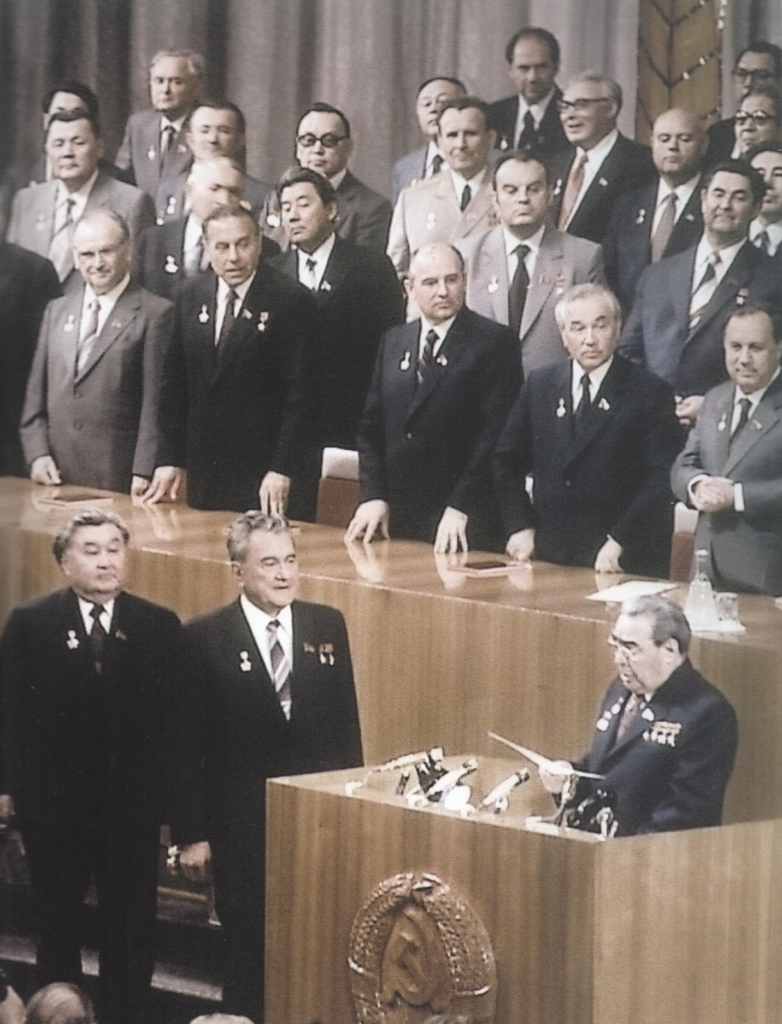
Presentation of Order of Lenin to Kazakhstan by L.I. Brezhnev. 1980.
Dinmukhamed Ahmetuly Konaev. Photo album. – Almaty: Almatykitap Baspasy, 2011. – P. 48.
In all the difficulties D.A. Kunaev remained a very modest and honest man. Brought up in the Soviet system, he remained faithful to the ideals that the Communist Party preached.
M.S. Gorbachev, elected in March 1985 as General Secretary of the CPSU Central Committee, announced a course of reconstruction and renewal. Build top managers nominated by L.I. Brezhnev, did not suit the new leader of the USSR.
D.A. Kunaev was among those whom the General Secretary of the CPSU Central Committee decided to replace.
Secretly, without notification, In Moscow decided to hold a formal Plenum on the re-election of the First Secretary of the Central Committee of the Communist Party of Kazakhstan D.A. Kunaev.
Held on December 16, 1986 the Plenum of the Central Committee of the Communist Party of Kazakhstan lasted only 17 minutes. Speaking at the Plenum of the Central Committee of the Communist Party of Kazakhstan G.P. Razumovsky briefly introduced those present to the Decision of the Politburo of the CPSU Central Committee on the release of D.A. Kunaev” connected with retirement” and in a directive form proposed to elect G.V. Kolbin – the head of the Ulyanov regional party organization [4].
The procedure of dismissal of the First Secretary D.A. Kunaev and the demonstrative appointment of a party completely unfamiliar to the population of the republic caused a storm of indignation. Young people, mainly students from Almaty, Karaganda, Kokshetau went out to the streets, openly expressing disapproval for the decision of Moscow.
There are especially large in Alma-Ata, where young people flocked to the central square in large groups.
The authorities, accustomed to the tacit consent of the people, decided to use military units and police in response. In the factories, “working squads” armed with metal objects were created.
The fact of disagreement ofpeople with the decision of Moscow to a large extent was a sign of recognition of D.A. Kunaev, who led the republic for a quarter century.
D.A. Kunaev later described these events as follows: “On December 17, at about 11 a.m., the second secretary of the Central Committee of the Communist Party of Kazakhstan (as in the text – by the author B.G. Ayagan), called Miroshkhin and asked me to come to the Central Committee. To my question: “What caused it? After all, I’m retired! ”, He replied: t“A group of youth gathered in the square. They demand clarification of the decision of the past Plenum of the Central Committee. It would be good for you to address the audience and explain the essence of the matter. ” “Good,” I replied, and asked: “Does Kolbin agree?”… Kolbin began negotiations with Moscow, Miroshkhin handed the phone to Kolbin, he asked me to come to the Central Committee and speak to the youth. I agreed.
After a short period of time, Kolbin gathered all the members of the Central Committee bureau and invited me: “You are free, have a rest. We will take action ourselves and put things in order.
Later, in many of his speeches, Kolbin accused me of categorically refusing to refer to the audience in the square. Saying a clear lie, he slandered me and misled all members of the Central Committee, all communists and working people of the republic.” [12, p. 291-293].
The inept actions of the authorities, stereotyped methods and simple disrespect for people led to bloodshed and deep tension in society. An innocent people died during the clash.
D.A. Kunaev wrote: “I ruled the country for 25 years. During this time, it was difficult to prevent at least one mistake per year. It turns out that in 25 years I made 25 mistakes. Therefore, during my trips to Kazakhstan, I was not only interested in the situation of the working people, but also in my minds I kept asking the people and the God forgiveness for my mistakes. After all, would you say this publicly or write in a newspaper? If I had done so, I would not have been able to rule the country. This is the right.” [1, p.60]. Archival materials on the events of December 1986 are not fully studied.
By its simplicity and intelligence D.A. Kunaev won great authority among the population not only of Kazakhstan, but also of the whole country. He was prouded of and loved.
As one of the leaders of the largest republic that was part of the USSR, D.A. Kunaev was widely known abroad. Jawaharlal Nehru, an outstanding statesman of India, praised D.A. Kunaev: “There is no greater happiness, to be the son of a magnanimous and kind people. This is the Kazakh people. And happy are the people who have a faithful son who honors his past and who sincerely works for his bright future. This great son is Dinmukhamed Kunaev. We have two similar qualities. The first is our simplicity, and the second – Almaty in its green outfit seemed to me the twin of our Kashmir. The amazing resemblance!” [1, p.190].
A whole generation of managers and specialists who have done a lot in the development of independent Kazakhstan has grown in Kazakhstan with the support of D.A. Kunaev. One of them was Nursultan Abishevich Nazarbayev – the First President – Elbasy, the founder of independent Kazakhstan, the builder of a new capital.
D.A. Kunaev lived a difficult life. Having reached the pinnacles of power, he was released from work with an unflattering formulation [4]. For some time, his name was devoted to defamation on the pages of the press. But he worthily passed all the tests [13, p. 146; 14, pp. 10-13; 15, pp. 11-12; 16, pp. 26-27; 17, pp. 98-109].
D.A. Kunaev knew a lot of technology and features of the functioning government, he saw a lot in his lifetime.He survived the Stalinist period, made his contribution to the formation of country in various periods of socialism. But he also witnessed the destruction of the Soviet country, the values of the communist ideology, which he firmly believed. D.A. Kunaev also witnessed the formation of independent Kazakhstan, the successes of which he sincerely rejoiced.
For his contribution to the development of the country, he was awarded the title of Hero of Socialist Labor three times. He was awarded eight orders of Lenin, other awards, including foreign ones.
In the memory of citizens of Kazakhstan D.A. Kunaev remained not only as a statesman,but also as a major organizer of science, a metallurgical engineer.
Memory
D.A. Kunaev died on August 22, 1993 as a result of myocardial infarction on the shores of Lake Alakol.
The name of D.A. Kunaev is highly respected by the people. By the decree of the first President of independent Kazakhstan N.A. Nazarbayev his name is immortalized in the names of streets, schools, enterprises. And university is named after him.
In the city of Almaty, during the D.A. Kunaev’s life, there was erected a monument to him as twice Hero of Socialist Labor.
According to the Decree of the President of the Republic of Kazakhstan N.A. Nazarbayev from February 24, 1994, (No. 1577) in recognition of D.A. Kunaev’s special services to Kazakhstan and in order to perpetuate his memory, the Institute of Mining of the National Academy of Sciences of the Republic of Kazakhstan, joint-stock company “Leninogorsk Polymetallic factory” of the East Kazakhstan region were given the name D.A. Kunaev, also Karl Marx Street in Almaty was renamed to D.A. Kunaev Street, there was organized the Museum House of D.A. Kunaev in Almaty and a memorial board was installed on the house where he lived. The same Decree established the annual award named after academician D.A. Kunaev in the field of Earth science for young scientists.
References:
1. Dіnmuhamed Ahmetuly Қonaev. Fotoal’bom. – Almaty: Almatykіtap baspasy, 2011. – 256 b.
2. «Kazahstan» Nacional’naja jenciklopedija t. 3 / Gl. red. B. Ajagan. – Almaty: Glavnaja redakcija «Қazaқ jenciklopedijasy», 2005. – 560 s.
3. Kunaev D. Ot Stalina do Gorbacheva (V aspekte istorii Kazahstana). – Almaty: «Sanat», 1994. – 352 s.
4. Arhiv Prezidenta Respubliki Kazahstan. – F. 708. – Op. 131. – D. 234.
5. Istorija Kazahstana (s drevnejshih vremen do nashih dnej). V pjati tomah. – Tom 4. – Almaty: «Atamura», 2009. – 768 s., tabl., ill., karty.
6. Kaken A. Kremlevskij kolobrod, ili Kak nemcam sozdavali avtonomiju. Dokumental’noe povestvovanie. – Astana: Foliant, 2013. – 352 s.
7. Konaev D. Otti dauren osylaj: Estelik-jesse / Қonaev, Dinmұhamed; Aud. zhәne red. Serik Abdirajymuly. – Almaty: Dәuir, Yntymaқ, 1992. – 445 b.
8. Golushko N.M. V specsluzhbah treh gosudarstv. – M.: «Redakcija» «Istoricheskaja gazeta», 2009. – 896 s.
9. Central’nyj Komitet KPSS prinjal postanovlenie «O rabote Kazahskoj respublikanskoj partijnoj organizacii po internacional’nomu i patrioticheskomu vospitaniju trudjashhihsja» / Kazahstanskaja pravda. – № 165 (19.591). – 1987. – 16 ijulja.
10. Nursultan Nazarbaev. Biografija. – Astana: Delovoj Mir Astana, 2012. – 304 s.
11. Istorija Kazahstana (s drevnejshih vremen do nashih dnej). V pjati tomah. – Tom 5. – Almaty: «Atamura», 2010. – 680 s., tabl., ill., karty.
12. XVI s’yezd Kommunisticheskoj partii Kazahstana. 6-8 fevralja 1986 goda: Stenograficheskij otchet. – Alma-Ata: Kazahstan, 1986. – 396 s.
13. Sagdiev M.R. Biіk arman aigagy: Omіrbajan hikajattary. – Almaty: Dajk-Press, 1999. – 236 b.
14. Tіlegenov B. Adebiet – menіn Otanym! (Estelіk zhazbalar) // Zhuldyz. – 1998. – № 7. – B. 10-13.
15. Isinaliev M. Shtrihi k portretam: nauchnoe izdanie / Isinaliev M. – Almaty: Sanat, 1999. – 239 s.
16. Kamalidenov Z. Estelіkter. Vospominanija (Қurap otyrgan Gani Karin). – Almaty: «Zerde», 2018. – 313 s.
17. Kenzhebaev S.D. Politicheskie portrety pervyh. – Almaty: «Қazaқ jenciklopedijasy», 2015. – 480 s.
Author:Ayagan B.G., Doctor of Historical Sciences, Professor
Photo Gallery life’s work of Kunaev D.A.
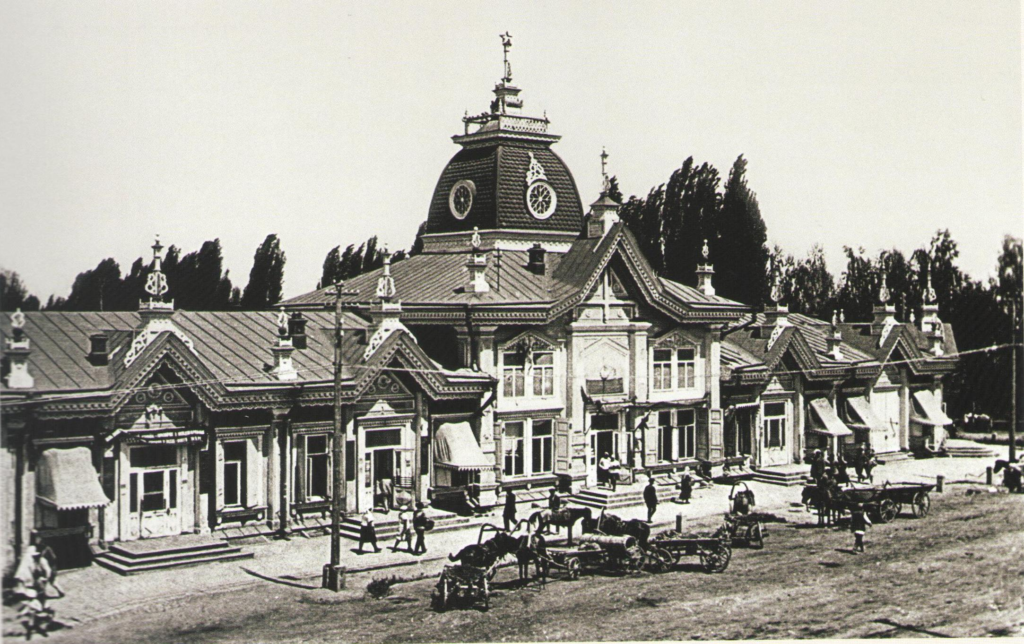
Trading house of the merchant Gabdulvaliev, the city of Verny
DinmukhamedAhmetuly Kunaev. Photo album. –Almaty: AlmatykitapBaspasy, 2011. – P. 20
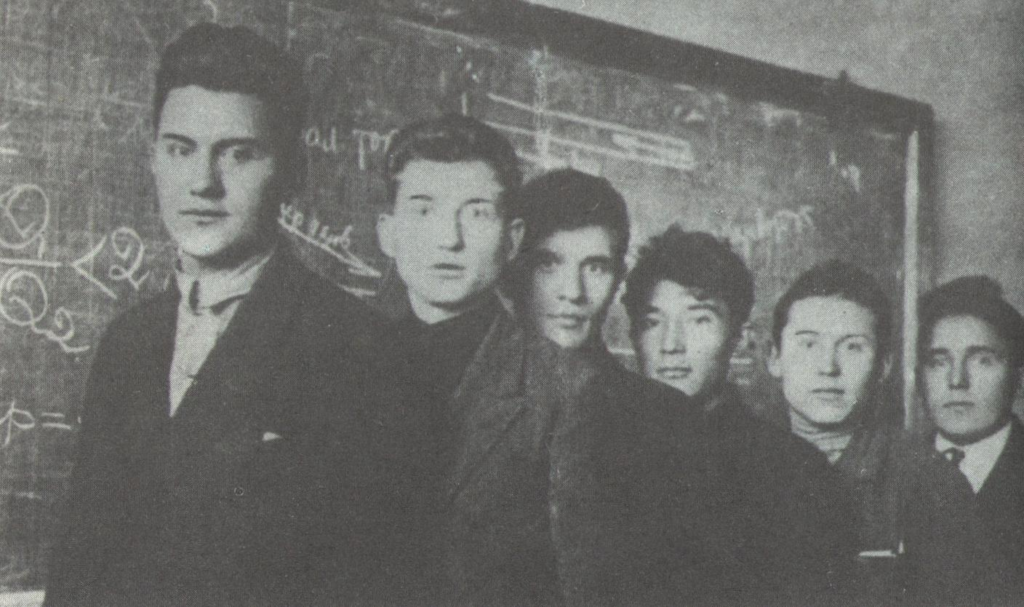
The Excellent pupils of the 2nd group of mining department of the faculty of Mintsvetmeta.
Kunaev D. From Stalin to Gorbachev (In the aspect of the history of Kazakhstan). – Almaty, “Sanat”, 1994. – the 8th page of the insert.

Kunaev D.A. 1948
Archive of the President of the Republic of Kazakhstan. F. 708. I. 131. Item unit No. 234
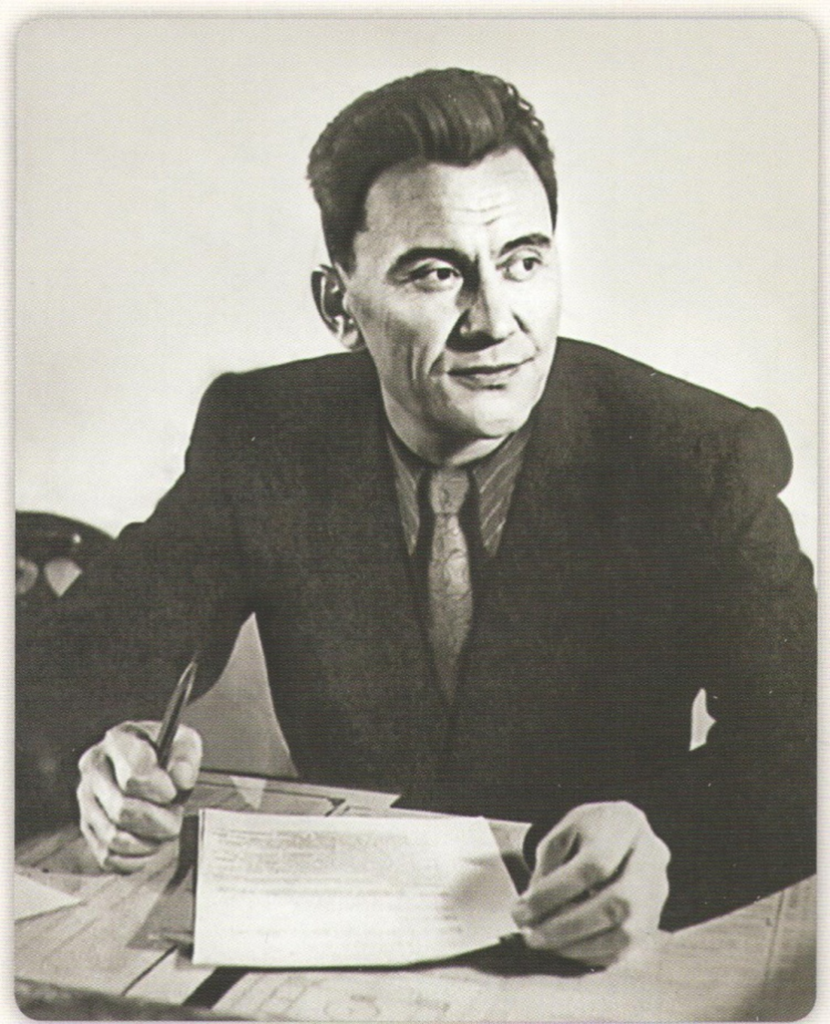
Kunaev D.A. the 50s
DinmukhamedAhmetuly Kunaev. Photo album. –Almaty: AlmatykitapBaspasy, 2011. – P.31

Kunaev D.A. – Chairman of the Council of Ministers of Kazakhstan. 1955
DinmukhamedAhmetuly Kunaev. Photo album. –Almaty: AlmatykitapBaspasy, 2011. – P.36

D.A. Kunaev, father Minliahmed Zhumabaiuly and mother ZaureBaiyrkyzy.
Personality. Memoirs about D.A. Kunaev/ Authors compilers: Abraimuly S., Goryainov A. – Almaty. 2007 – P. 80
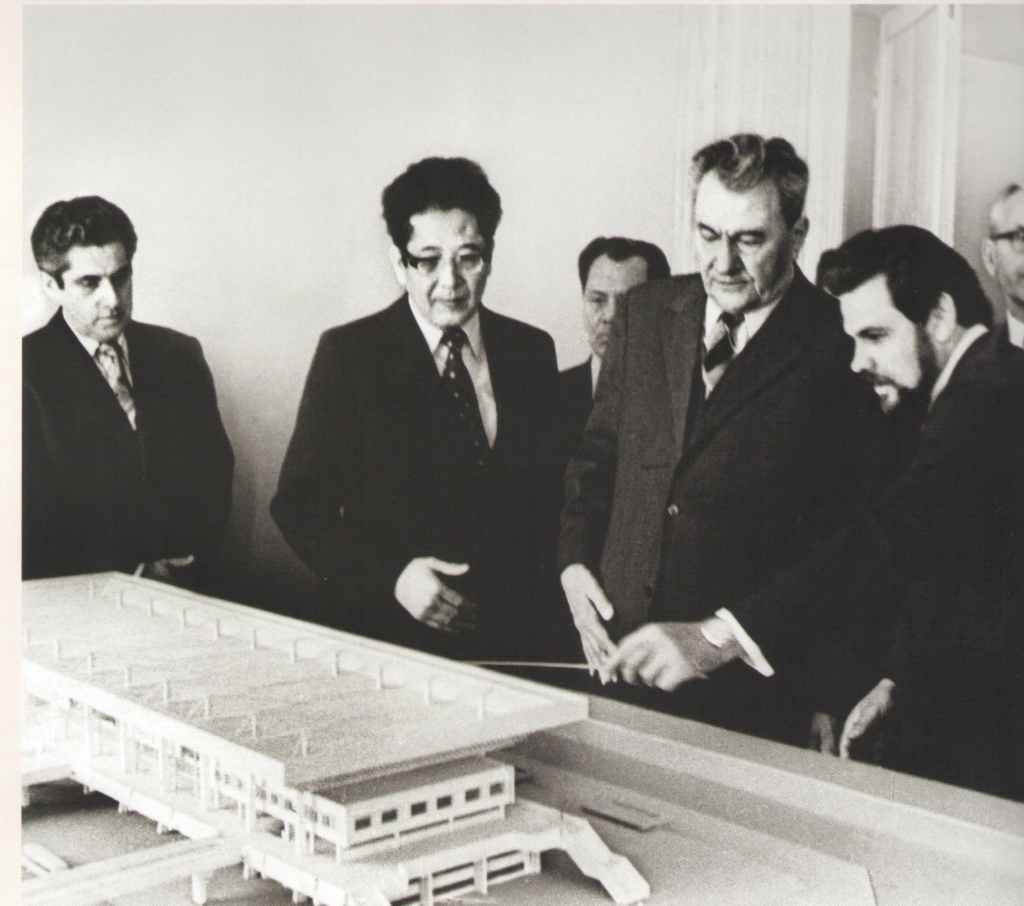
Dinmukhamed Ahmetuly Kunaev. Photo album. –Almaty: Almatykitap Baspasy, 2011. – P. 156

The General Secretary of the CPSU Central Committee Leonid Ilyich Brezhnev and member of the Politburo of the CPSU Central Committee, the First Secretary of the Central Committee of the Communist Party of Kazakhstan DimashAkhmedovich Kunaev, 1978
Personality. Memoirs about D.A. Kunaev/ Authors compilers: Abraimuly S., Goryainov A. – Almaty. 2007 – P. 80
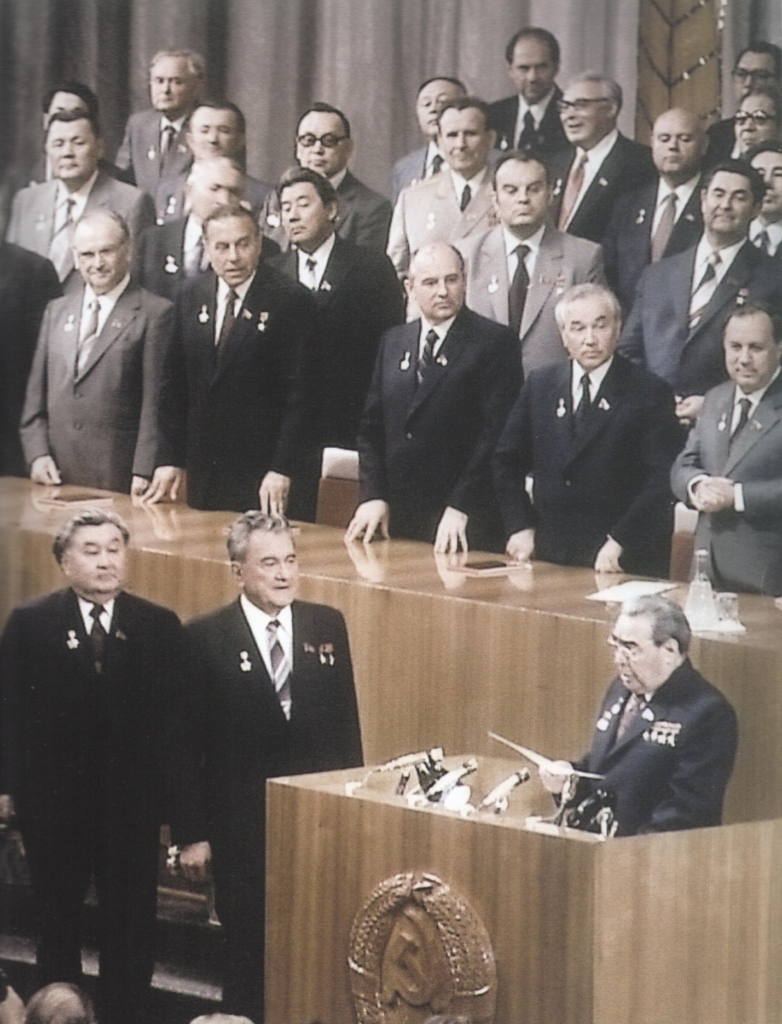
Presentation of Order of Lenin to Kazakhstan by L.I. Brezhnev. 1980.
DinmukhamedAhmetuly Kunaev. Photo album. –Almaty: AlmatykitapBaspasy, 2011. – P.48

Kunaev D.A.
DinmukhamedAhmetuly Kunaev. Photo album. –Almaty: AlmatykitapBaspasy, 2011. – P.3
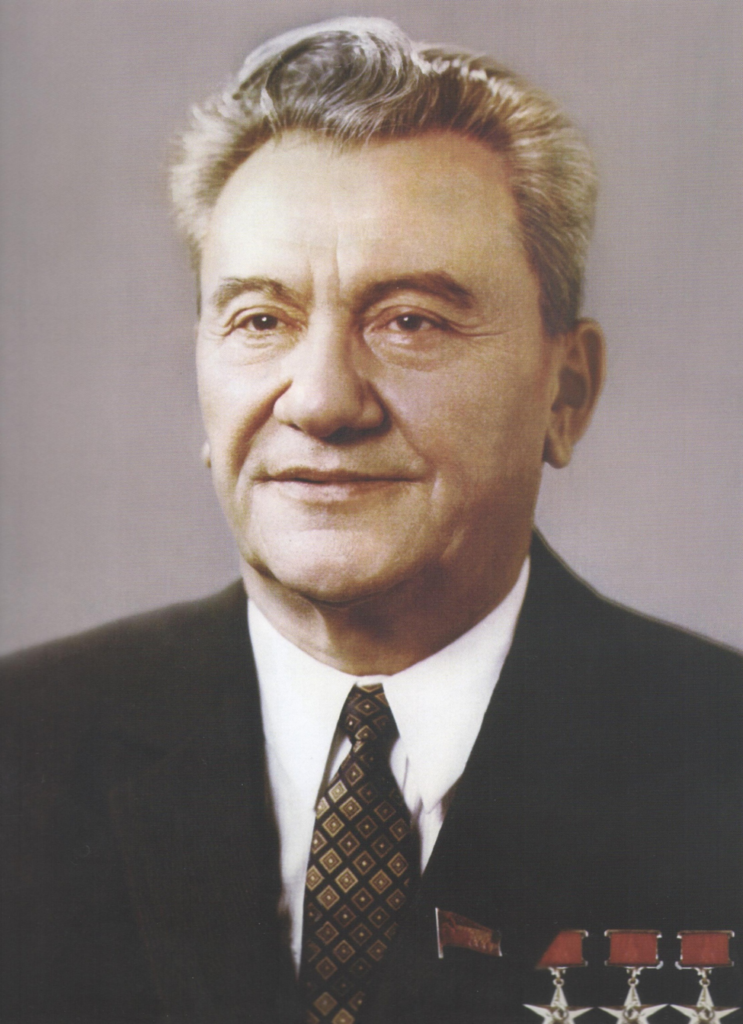
Kunaev D.A.
DinmukhamedAhmetuly Kunaev. Photo album. –Almaty: AlmatykitapBaspasy, 2011. – P.3
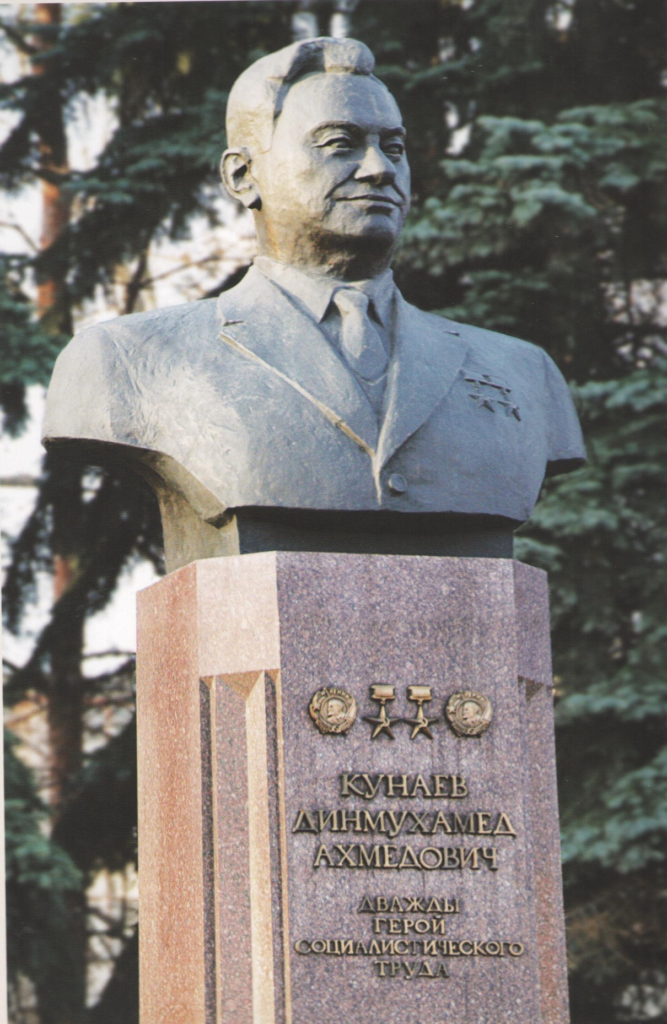
Bust of Kunaev D.A., installed in Almaty
DinmukhamedAhmetulyKonaev. Photo album. –Almaty: AlmatykitapBaspasy, 2011. –P.244
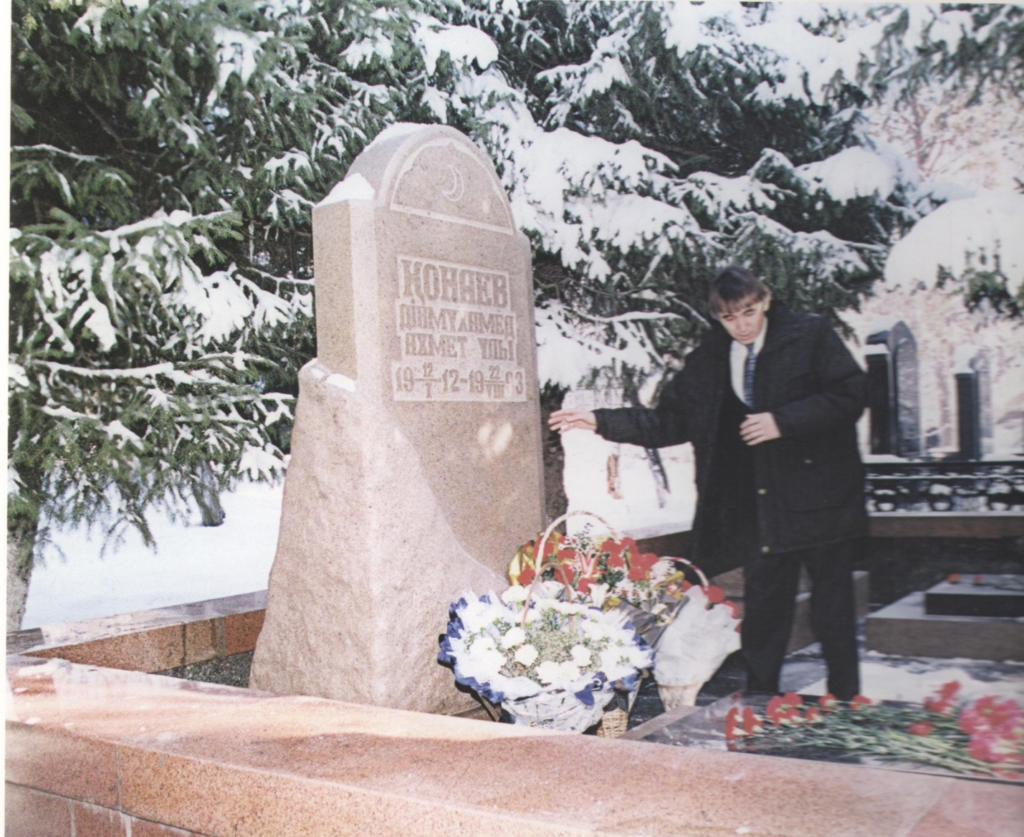
Monument of Kunaev D.A. at the Kensai cemetery
DinmukhamedAhmetulyKonaev. Photo album. –Almaty: AlmatykitapBaspasy, 2011. –P.247




